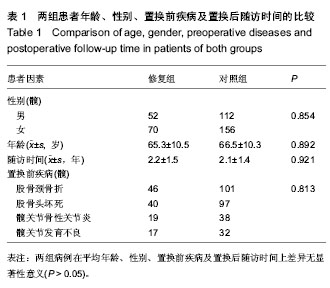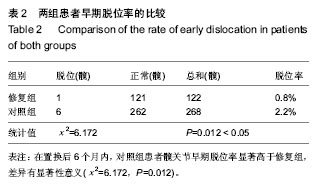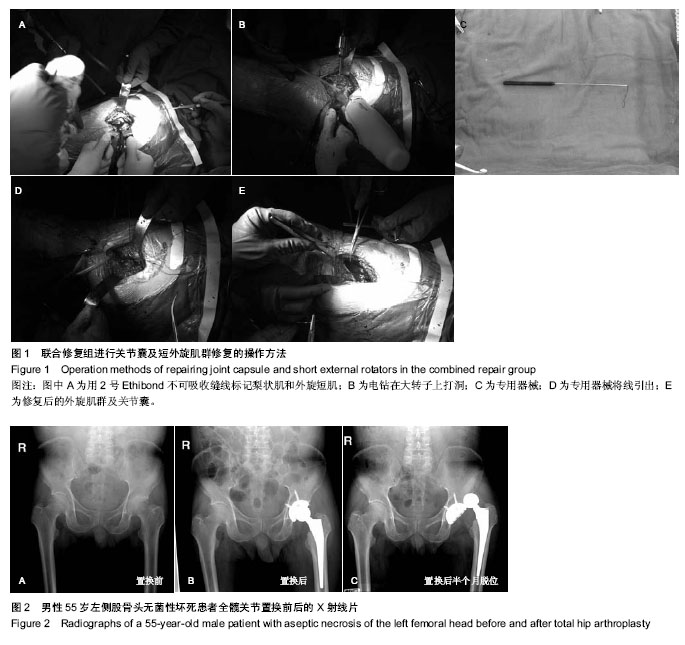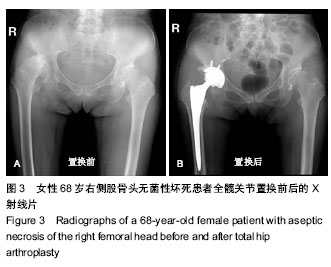| [1] Morrey BF. Instability after total hip arthroplasty.Orthop Clin North(Am). 1992;23:237-248.
[2] Jolles BM,Zangger P,Leyvraz PF.Factors predisposing to dislocation after primary total hip arthroplasty:a multivariate analysis.J Arthroplasty. 2002;3:282-288.
[3] Kim YH,Choi Y,Kim JS. Influence of patient- ,design- ,and surgery-related factors on rate of dislocation after primary cementless total hip arthroplasty. J Arthroplasty. 2009;8: 1258-1263.
[4] Lubbeke A,Suva D,Perneger T,et al. Influence of preoperative patient education on the risk of dislocation after primary total hip arthroplasty. Arthritis Rheum. 2009;4: 552-558.
[5] Taljanovic MS,Benjamin JB, Jones MD,et al.Joint arthroplasties and prostheses. Radiographics. 2003;5: 1295-1314.
[6] Mazoochian F,Pietschmann MF. Hip dislocation following THA. Orthopade. 2007;10:935-943.
[7] 卢世壁主译.坎贝尔骨科手术学[M].11版.北京:人民军医出版社, 2009:330.
[8] Mihalko WM, Whiteside LA. Hip mechanics after posterior structure repair in total hip arthroplasty. Clin Orthop Relat Res. 2004;(420):194-198.
[9] Sculeo TP,Moran MC. Posterior tenocapsulorthappy in primary total hip arthroplasty.American Academy of Orthop Surgeons. Anaheim: 1991.
[10] Kao JT, Woolson ST.Piriformis tendon repair failure after totalhip replacement. Orthop Rev. 1992;21(2): 171-174.
[11] Stähelin T, Vienne P, Hersche O. Failure of reinserted short external rotator muscles after total hip arthroplasty. J Arthroplasty. 2002; 17(5):604-607.
[12] 徐利明,朱炳斌,蒋毅,等.全髋关节置换术后早期后脱位的原因分析[J].中国骨伤,2010,23(3):187-188.
[13] 黄志强.微创外科与外科微创化—21世纪外科的主旋律[J].中华外科杂志,2002,40(1):9.
[14] 史振才,李子荣,介国斌,等.全髋关节置换术的软组织平衡[J].中国矫形外科杂志,2005,13(4):306-309.
[15] 李晓华,周维江,吴海山,等.全髋关节置换术后脱位原因和处理[J].中国矫形外科杂志,2001,8(8):771-773.
[16] Dixon MC,Scott RD,Schai PA,et al. A simple capsulorrhaphy in a posterior approach for total hip arthroplasty. J Arthroplasty. 2004;19(3):373-376.
[17] Whitere RE Jr,Forness TJ,Allman JK, et al. Effect of posterior capsular repair on early dislocation in primary total hip replacement. Clin Orthop Relat Res. 2001;(393):163-167.
[18] Sioen W,Simon JP, Labey L, et al. Posterior transosseous capsulotendinous repair in total hip arthroplasty:a cadaver study. J Bone Joint Surg Am. 2002;84 A (10):1793-1798.
[19] Zhang Y, Pei F, Zhang C, et al. Modified posterior soft tissue repair for the prevention of early postoperative dislocation in total hip arthroplasty. Int Orthop. 2013;8: 1643.
[20] Browne JA, Pagnano MW. Surgical technique: a simple soft-tissue-only repair of the capsule and external rotators in posterior-approach THA. Clin Orthop. 2012;2: 511-515.
[21] Mihalko WM, Whiteside LA. Hip mechanics after posterior structurerepair in total hip arthruplasty. Clin Orthop Relat Res. 2004;(420):194-198.
|



